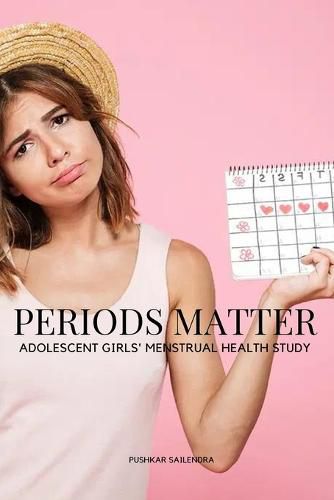Readings Newsletter
Become a Readings Member to make your shopping experience even easier.
Sign in or sign up for free!
You’re not far away from qualifying for FREE standard shipping within Australia
You’ve qualified for FREE standard shipping within Australia
The cart is loading…






This title is printed to order. This book may have been self-published. If so, we cannot guarantee the quality of the content. In the main most books will have gone through the editing process however some may not. We therefore suggest that you be aware of this before ordering this book. If in doubt check either the author or publisher’s details as we are unable to accept any returns unless they are faulty. Please contact us if you have any questions.
The United Nations define adolescents as persons aged between 10-19 years
for statistical purposes. Between puberty and maturity, adolescence is a phase of
transition and development. There is approximately 1198.7 million adolescent
worldwide (the United Nations' World Population Prospects: The 2012 Revision,
June 2013) and as per census 2011, -India comprises 253.2 million adolescents
constituting 20.9% of the total population of the country which estimates that every
fifth person in India is an adolescent||. The number of Adolescents living in rural
areas was 180.7 million as per census 2011 accounting for 72% of the total adolescent
population of the nation. While -Uttar Pradesh ranks first with the maximum number
of adolescents comprising 24.8% of the total population of the state||, Uttarakhand,
the carved state of Uttar Pradesh (since 2000) on the other hand comprises a total of
23% of adolescents In rural areas of its total population (Census. 2011).
Adolescents learn from their peers' social behaviour and the environment in
which they live during this time. (Ramadass. et.al., 2017). It is also a span of their
growth extending from the immaturity of childhood to the physical and psychological
maturity of adulthood. (WHO,1989). Around the age of 10-13, girls begin to
experience physical growth spurts. They usually begin breast development in their
tenth year, genital growth in their eleventh year, and menstruation in their twelfth
year. For the next three years, the growing process continues, and all secondary
sexual traits emerge (Petterson & Hale, 1985). Sexual development often occurs in
three stages-pre-pubescence, pubescence and post-pubescence. Prepubescence is
characterised by increased bodily growth, particularly of the reproductive organs, as
well as the emergence of secondary sex traits, including menstruation.
Menstruation is a natural physical process that occurs as a by-product of a
biological event. It is the visible manifestation of periodic uterine bleeding sloughed
from the endometrium. In other words, It is the monthly bleeding of non-pregnant
women of childbearing age (Chawla, 1992). Although menstrual bleeding is a re
$9.00 standard shipping within Australia
FREE standard shipping within Australia for orders over $100.00
Express & International shipping calculated at checkout
This title is printed to order. This book may have been self-published. If so, we cannot guarantee the quality of the content. In the main most books will have gone through the editing process however some may not. We therefore suggest that you be aware of this before ordering this book. If in doubt check either the author or publisher’s details as we are unable to accept any returns unless they are faulty. Please contact us if you have any questions.
The United Nations define adolescents as persons aged between 10-19 years
for statistical purposes. Between puberty and maturity, adolescence is a phase of
transition and development. There is approximately 1198.7 million adolescent
worldwide (the United Nations' World Population Prospects: The 2012 Revision,
June 2013) and as per census 2011, -India comprises 253.2 million adolescents
constituting 20.9% of the total population of the country which estimates that every
fifth person in India is an adolescent||. The number of Adolescents living in rural
areas was 180.7 million as per census 2011 accounting for 72% of the total adolescent
population of the nation. While -Uttar Pradesh ranks first with the maximum number
of adolescents comprising 24.8% of the total population of the state||, Uttarakhand,
the carved state of Uttar Pradesh (since 2000) on the other hand comprises a total of
23% of adolescents In rural areas of its total population (Census. 2011).
Adolescents learn from their peers' social behaviour and the environment in
which they live during this time. (Ramadass. et.al., 2017). It is also a span of their
growth extending from the immaturity of childhood to the physical and psychological
maturity of adulthood. (WHO,1989). Around the age of 10-13, girls begin to
experience physical growth spurts. They usually begin breast development in their
tenth year, genital growth in their eleventh year, and menstruation in their twelfth
year. For the next three years, the growing process continues, and all secondary
sexual traits emerge (Petterson & Hale, 1985). Sexual development often occurs in
three stages-pre-pubescence, pubescence and post-pubescence. Prepubescence is
characterised by increased bodily growth, particularly of the reproductive organs, as
well as the emergence of secondary sex traits, including menstruation.
Menstruation is a natural physical process that occurs as a by-product of a
biological event. It is the visible manifestation of periodic uterine bleeding sloughed
from the endometrium. In other words, It is the monthly bleeding of non-pregnant
women of childbearing age (Chawla, 1992). Although menstrual bleeding is a re